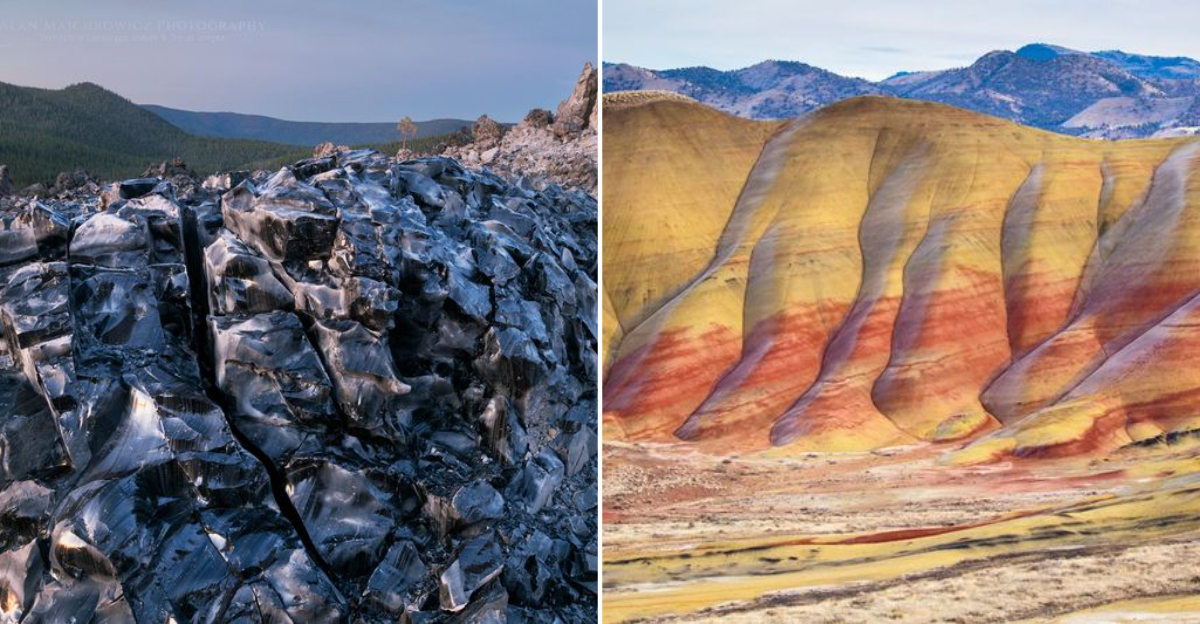10 Strange But Beautiful Natural Wonders In Oregon You Won’t Believe Are Real

Oregon’s wild beauty comes with some seriously strange sights. Imagine volcanic rock shapes that look like something out of a fantasy tale and sinkholes that seem to appear out of nowhere.
Lace up your boots and get ready to snap photos that’ll have everyone wondering if you’ve been editing your shots.
1. Thor’s Well: Nature’s Saltwater Sinkhole
Standing at the edge of Thor’s Well feels like watching Earth drink the Pacific Ocean. Located near Yachats along the Oregon coast, this circular chasm appears to drain seawater endlessly into some mysterious underground abyss.
I nearly lost my footing when I visited during high tide, when the spectacle is most dramatic. Formed when a sea cave’s roof collapsed, this roughly 20-foot deep hole creates spectacular water displays as waves rush in and violently drain away.
2. Painted Hills: Earth’s Rainbow Canvas
Mother Nature must have been feeling particularly artistic when creating the Painted Hills. These rolling mounds showcase bands of red, gold, black, and orange that shift colors depending on weather conditions and time of day.
The vivid stripes formed over 35 million years as volcanic ash and minerals layered and compressed. Walk the short trails that loop around these geological masterpieces for different perspectives, but remember to stay on designated paths to protect these delicate formations.
3. Crater Lake & Wizard Island: A Volcano Within A Volcano
Gazing at America’s deepest lake feels like peering into another dimension. The impossibly blue water contrasts sharply with the volcanic cone of Wizard Island rising from its surface.
During my summer visit, I took the boat tour around this magical landscape and couldn’t believe the water clarity – visibility extends nearly 100 feet down!
The lake formed after Mount Mazama erupted and collapsed 7,700 years ago, while Wizard Island is actually a cinder cone that grew afterward from the crater floor.
4. Alvord Desert: The Unexpected Playa
Stumbling upon a vast desert playa in Oregon seems impossible until you visit the Alvord. This perfectly flat, cracked earth stretches for miles beneath the towering Steens Mountain, creating a surreal landscape that feels transplanted from another planet.
During dry months, the hard-packed surface becomes so smooth that adventurous visitors have set land-speed records here.
The desert sits in a rain shadow, receiving just 7 inches of precipitation annually, while nearby mountains catch all incoming moisture.
5. Tamolitch Blue Pool: The Sapphire That Shouldn’t Exist
Hidden along the McKenzie River Trail sits a pool of water so vibrantly blue it looks digitally enhanced. The Tamolitch Blue Pool appears almost illuminated from within, with a color intensity that defies logic.
I hiked the moderate 2-mile trail last spring and gasped when the pool came into view. This natural phenomenon occurs where the McKenzie River resurfaces after flowing underground through ancient lava tubes.
The water’s exceptional clarity and mineral content create the striking blue that seems to glow in the forest setting.
6. Crack-in-the-Ground: Earth’s Hidden Passageway
Walking through this volcanic fissure feels like entering a secret passage to the center of Earth. This two-mile-long, 70-foot-deep crack slices through the high desert landscape near Christmas Valley, offering a natural air conditioning effect in summer.
The temperature inside can be up to 20 degrees cooler than the surface, creating a refreshing microclimate.
Formed thousands of years ago by fissuring and subsidence along a volcanic rift, the narrow passages require some scrambling but reward explorers with unique rock formations and surprising plant life.
7. Big Obsidian Flow: A River of Glass
Stepping onto the Big Obsidian Flow feels like walking across a frozen black glass river. This massive field of volcanic glass covers nearly one square mile and sparkles dramatically in sunlight.
The glossy black rock formed just 1,300 years ago when rhyolitic lava erupted and cooled rapidly, making it one of Oregon’s youngest geological features. Native tribes once harvested this natural glass to craft razor-sharp tools and weapons.
The short interpretive trail offers close-up views of this otherworldly landscape.
8. Fort Rock: The Ancient Sea Stack
Rising abruptly from the flat desert floor, Fort Rock’s curved walls form a massive ring that early settlers thought resembled a frontier fortress.
This incredible formation stands about 200 feet tall and spans nearly a mile in diameter. During my visit last fall, I couldn’t help imagining the ancient lake that once surrounded this tuff ring.
Fort Rock formed approximately 100,000 years ago when molten basalt erupted through the water of a vast Ice Age lake, creating explosive steam that scattered volcanic ash into this distinctive circular shape.
9. Toketee Falls: The Perfect Double-Drop
Nature rarely creates such geometric precision as seen at Toketee Falls. The water plunges in two perfect stages over exposed columnar basalt formations that look almost architectural in their regularity.
The upper tier drops 40 feet before the lower section cascades another 80 feet into a serene emerald pool. These hexagonal basalt columns formed when thick lava cooled slowly, allowing crystals to align in perfect geometric patterns.
The viewing platform at the end of a short forest trail offers the classic postcard view.
10. Pillars of Rome: Oregon’s Ancient Badlands
Looming above the Owyhee Desert stand pale clay cliffs that early pioneers thought resembled the ruins of classical Roman temples. These weathered formations stretch for several miles, reaching heights of over 100 feet.
The Pillars of Rome were once the shoreline of an ancient lake that covered the region millions of years ago. Wind and water erosion sculpted these soft clay deposits into their current cathedral-like appearance.
Unlike most Oregon landmarks, these remote formations receive few visitors, offering a true wilderness experience for those willing to make the journey.
